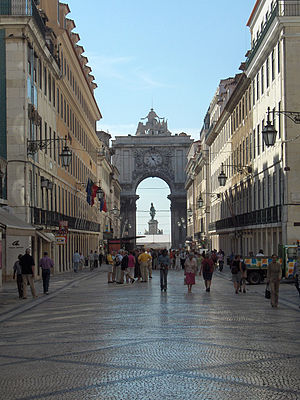Baixa of Lisbon

The Baixa of Lisbon (traditionally Baixa Pombalina , in German lower town ) is the heart of the Portuguese capital Lisbon . The district extends over 235,620 square meters, north of Praça do Comércio , roughly between the traffic junction Cais do Sodré and the Alfama district , south of the Castelo de São Jorge . After the devastating earthquake of 1755 , the Baixa was completely rebuilt. The Baixa is the primary focal point for many visitors to the city. Here you will find the first contact with the typical atmosphere and the Calçada Portuguesa , as well as its many sights and restaurants.
The district is an elegant neighborhood that was commissioned to be built immediately after the 1755 earthquake . The district got its name from Marquês de Pombal , a Portuguese nobleman who was Prime Minister of the country from 1750 to 1777 and played a crucial role in the reconstruction of Lisbon. After the earthquake, the margrave no longer planned the city according to geographical conditions, but instead designed a strictly geometric road network.
The Baixa is a good example of the early development of earthquake-proof construction . The resilience of the facilities was tested by letting military troops march around architectural models to simulate a light earthquake.
The Portuguese government put the Baixa on December 7, 2004 on the national proposal list for UNESCO World Heritage .
In the Baixa is next to the Banco de Portugal and the former Banco Nacional Ultramarino in the Rua Augusta, the Museu do Design e da Moda (MUDE), a design and fashion museum, u. a. the Farmácia Normal pharmacy and the Armazéns Grandella .
Individual evidence
- ↑ a b c Description of the Baixa on the World Heritage list
- ↑ Anthony N. Penna and Jennifer S. Rivers: Natural Disasters in a Global Environment , John Wiley & Sons (2013), p. 78
Web links
- Lisbon tourist info
- Lisbon Tourist Information (en / pt / fr / es)
Coordinates: 38 ° 43 ′ N , 9 ° 8 ′ W